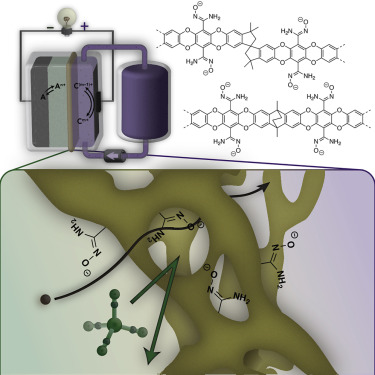Joule ( IF 39.8 ) Pub Date : 2019-10-10 , DOI: 10.1016/j.joule.2019.08.025 Miranda J. Baran , Miles N. Braten , Swagat Sahu , Artem Baskin , Stephen M. Meckler , Longjun Li , Lorenzo Maserati , Mark E. Carrington , Yet-Ming Chiang , David Prendergast , Brett A. Helms

|
Here, we lay the design rules for linking microporous polymer membrane architecture and pore chemistry to membrane stability, conductivity, and transport selectivity in aqueous electrolytes over a broad range of pH. We tie these attributes to prospects for crossover-free electrochemical cell operation. These guiding principles are applied to two emerging cell chemistries for grid batteries: specifically, Zn–TEMPO-4-sulfate and Zn–K4Fe(CN)6 cells. Key to our success is the placement of ionizable amidoxime functionalities, which are stable at high pH, within the pores of microporous ladder polymer membranes, yielding a family of charge-neutral and cation exchange membranes at low and high pH, respectively—which we call AquaPIMs. Their notably high conductivity (up to 21.5 mS cm−1 in 5.0 M aqueous KOH) and high transport selectivity (up to 104 reduction in active-material permeability through the membrane) suggest exciting opportunities for battery development, even beyond those presently demonstrated.
中文翻译:

无交叉水电化学装置的内在微孔性聚合物膜的设计规则
在这里,我们奠定了将微孔聚合物膜结构和孔化学与膜的稳定性,电导率和在宽范围的pH范围内的水性电解质中的迁移选择性联系起来的设计规则。我们将这些属性与无交叉电化学电池操作的前景联系在一起。这些指导原则适用于两种新兴的网格电池化学电池:具体地说,是Zn–TEMPO-4-硫酸盐和Zn–K 4 Fe(CN)6电池。我们成功的关键是在微孔梯状聚合物膜的孔中放置可电离的a胺肟官能团,该官能团在高pH下稳定,从而分别在低pH和高pH下产生一类电荷中性膜和阳离子交换膜,我们称之为AquaPIM。它们极高的电导率(高达21.5 mS cm在5.0 M的KOH水溶液中为-1)和高的运输选择性(活性物质透过膜的渗透率最多降低10 4),为电池开发提供了令人兴奋的机会,甚至超出了目前所展示的机会。



























 京公网安备 11010802027423号
京公网安备 11010802027423号